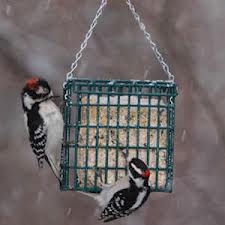 Our year-round resident cavity nesters are getting busy with courtship and breeding behaviours, well ahead of the migrants, most of whom start returning from their southern breeding grounds in late-April. Behaviours to watch and listen for include calling/singing (nuthatches & chickadees), drumming (woodpeckers), ritualized displays (keep an eye open for dance-like movements between birds), and scouting potential nest sites. If learning bird vocalizations interests you, check out this blog post from April 2019 (Bird Song vs. Call & Tips to Learn a Few in Your Yard).
Our year-round resident cavity nesters are getting busy with courtship and breeding behaviours, well ahead of the migrants, most of whom start returning from their southern breeding grounds in late-April. Behaviours to watch and listen for include calling/singing (nuthatches & chickadees), drumming (woodpeckers), ritualized displays (keep an eye open for dance-like movements between birds), and scouting potential nest sites. If learning bird vocalizations interests you, check out this blog post from April 2019 (Bird Song vs. Call & Tips to Learn a Few in Your Yard).
Some cavity nesters are “primary” cavity nesters, meaning they excavate their own holes in trees each year (e.g., Pileated Woodpecker). Others are “secondary” cavity nesters, meaning they use old unused cavities excavated by other species (e.g., Northern Flicker), and some of them do a bit of both (e.g., Black-capped Chickadees). Bird houses are used by those species who nest in pre-existing cavities, and it’s not too late to clean existing or set up new bird houses in the hope of enticing some of these charismatic characters to use your yard.
The combination of winter and increasing breeding activity has these birds needing food! Many of you have been sharing your experiences with woodpeckers, including Red-bellied and Pileated, coming to your feeders. In two recent Garden Gate episodes, we talked about suet and suet feeders. Some species enjoy food right at the feeder, while others may be inclined to snag a snack and eat it under cover to be safer from predators or to stash the seeds elsewhere for future use.
Here are a few interesting factoids about some of our resident cavity nesters…
- Black-capped Chickadees remove chips from the ground under their nest excavation and drop them somewhere else to reduce evidence that could help potential nest predators find their nest site.
- Perhaps you’ve noticed that both nuthatch species (Red-breasted and White-breasted) spend most of their time upside-down on tree trunks and limbs. They feed on seeds and insects, and this strategy allows them to find food from an angle that most other species don’t. Another year-round resident, the Brown Creeper (which nests under the sloughed-off bark of old dead trees in forests and woodlots and therefore rarely shows up in our backyards), does the opposite, searching for food in nooks and crannies as it moves up a tree’s trunk. This separation among species in how they use the same habitat features is called “niche partitioning,” which allows them to co-exist without competing for food. Another example of niche partitioning is the relative bill length of the Downy, Hairy, and Pileated Woodpeckers.
- Black-capped Chickadees collect and cache seeds to help them get through the winter. They can remember thousands of locations to get through the winter.
Woodpeckers’ brains are cushioned to prevent concussions from pounding their heads against trees, and their tongues extend up into the backs of their heads and attach to the front of their skulls, allowing them to extend several head lengths out when feeding.
